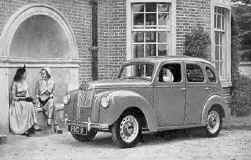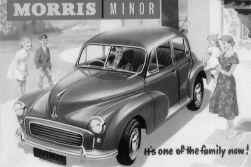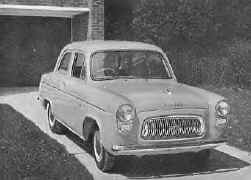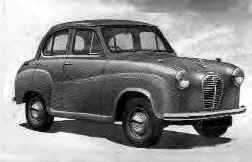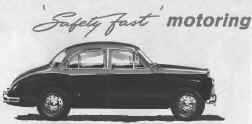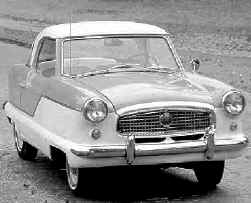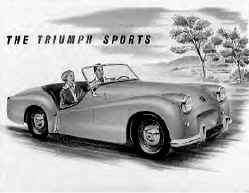Source Cars |
|
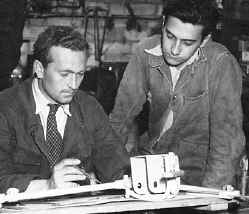
|
The Lotus Eleven used many parts and major assemblies from production cars. Some of these components were straight from the shelves of the manufacturers while others were ingeniously modified and not immediately recognizable as production items. Some of the most clever innovations came from sourcing items no longer in production, but available for minimum cost from scrap yards. This was all in the Lotus tradition. Colin Chapman's first car, eventually called the LOTUS Mark 1, was one built in 1947-8 from the shell of a derelict Austin 7. The Lotus Mk 2, finished in 1949, was also built up from an Austin 7 but had a sturdier Ford beam axle at the front. These cars had their beam axles cut in half with pivot points placed in the center to provide independent front suspension. For the Mk 6 Lotus used the Ford E93 beam axle and radius arm, cut, bent and re-welded into something very different from that seen in any Ford. It was simple and effective. The Eleven retained the front suspension components of the E93, once again cut into a swing-axle, but tweaked for a lower roll center than before. Many a seasoned mechanic has looked inside an Eleven’s bonnet for the first time, expecting bold technology, only to become fixated on the obviously ancient I-beam axles (This thing is older than I am !) and vaguely familiar radius arms. Chapman's resourcefulness in building the best handling sports racer with suspension parts from junked parts of pre-war Ford design is still a wonder . Just behind the Ford axle was a slightly modified rack & pinion assembly from a Morris Minor, a car renowned for its quick steering. A young mechanic named Graham Hill did the modifying and fit the brackets that would hold it in the car. Moving outboard, Club and Sports models used drum brake assemblies composed of a variety of production items modified to fit the Ford hub flanges. The engine of the Sports Eleven was that of a Ford 100E, complete with sidevalves and a simple carburetor, an extremely common motor in the UK at the time. Conveniently, high-performance accessories for these engines were available and listed in little adverts in the back pages of magazines. These items are today more rare than Climax parts. The 3-speed transmission of the Sports was also Ford. The transmissions on most Elevens came from Austin, of a specification normally fitted to the A30 sedan (and similar to that fitted to the Sprite Mk 1). This was a compact, lightweight gearbox with very pleasant shift characteristics. Stronger clutches were fitted. A Lotus modification for the LeMans (at extra cost) was a set of close-ratio gears. This proved a source of trouble for the gearbox by compounding the high rotational speeds the Climax engine exerted on it. Bearings, shafts and splines already strained from the RPMs of the race engine could go over the top from the horsepower load. Gearbox failure was not uncommon, and the sight of a “tranny” being pulled from a spectator’s car in the paddock to provide one for the race wasn’t unusual. As an alternate transmission Lotus could also supply one from an MG, very similar to that of the MGA but with a few parts from the Magnette. This gearbox was bulletproof in use but also much heavier and bulky enough to require a different contour to the transmission tunnel. The MG ‘box was normal equipment on Climax FWB-powered cars but, strangely, a few Club Elevens with FWA’s had them too. Reliability was the overriding issue with this choice, as along with the weight penalty there was also an increase in driveline power loss. They could be a difficult fit too: requiring a Swiss-cheese treatment to the bellhousing to allow it to clear the S-1 frame tubes. The rear axle on Club and Sports Elevens was also Austin, but this was a spec intended for the Metropolitan. Very similar to that fitted later to the Sprite, the Metropolitan axle was an inch wider and had the benefit of larger drum brakes. To accommodate wire wheels a pair of bolt-on splined hubs from the TR-2 were added. The ring & pinion carrier assembly on the Austin axle was the same A-series type in LeMans cars. In the Club & Sports models the ratio was nearly always the same 4.55 as fitted to the production car, while LeMans Elevens had a variety of ratios. Switchgear, electrical components, and small items around the Eleven came mostly from the BMC parts bin. Various bits can be traced to specific cars such as the ignition / light switch from the MG-TC, or a brake fluid reservoir from the TR-2 or 3. The list goes on and on. It was well known around London 50 years ago that if a person could lay his hands on some of the special castings, brackets and fittings that were exclusively Lotus, all of the rest of the car could be bought elsewhere. A body could be done by several sources, a frame by others, and soon a whole kit could be collected. Some people took the ads seriously about “building their own Lotus.” They would go scrounge the breakers yards and improvise, as Chapman had done in the first place. |
|
Jay Sloane |
|
| back to: Design & Production | |
| HOME: www.lotuseleven.org | |
